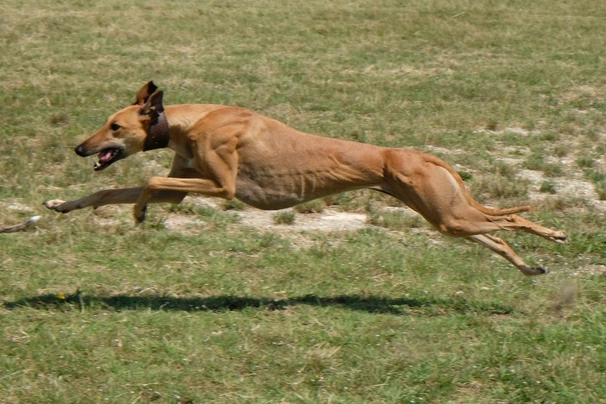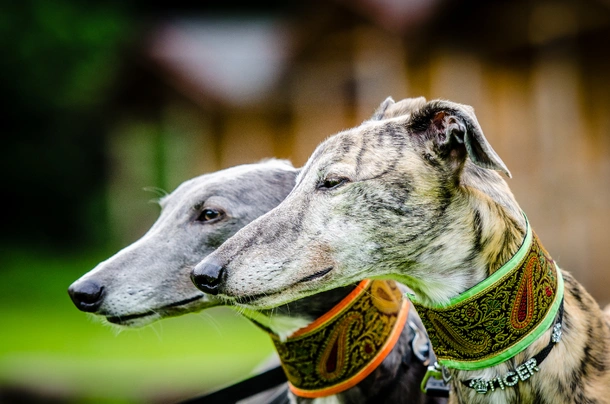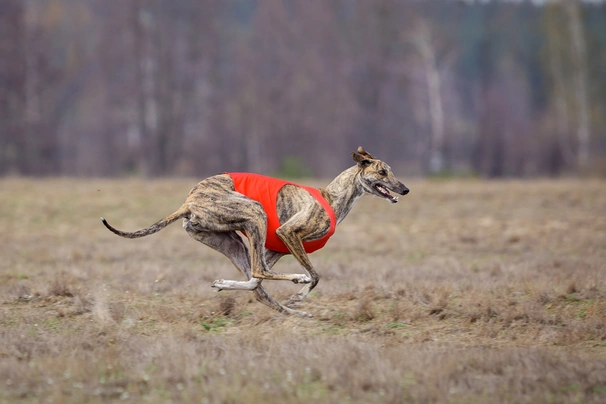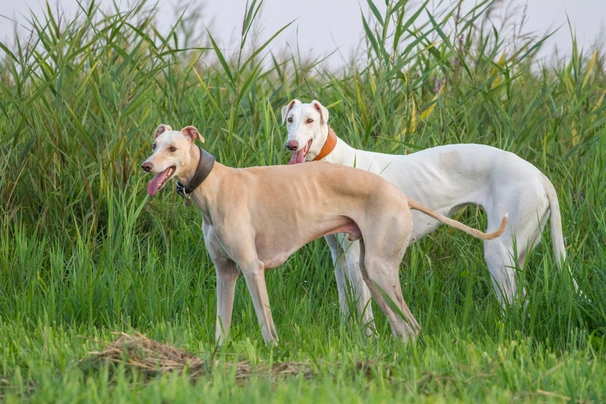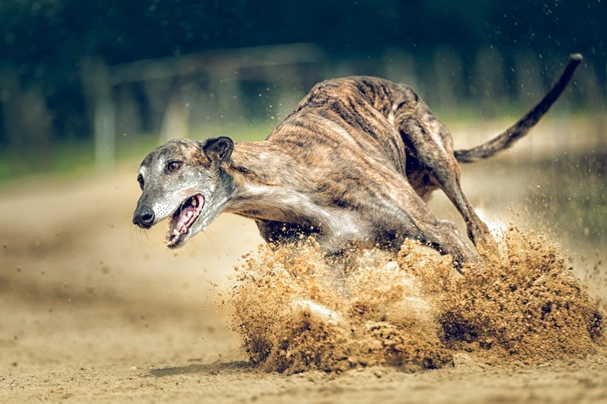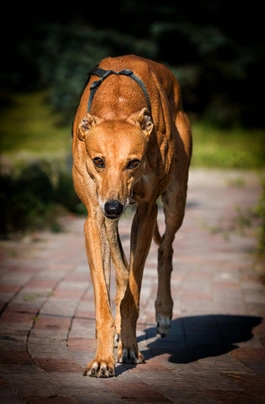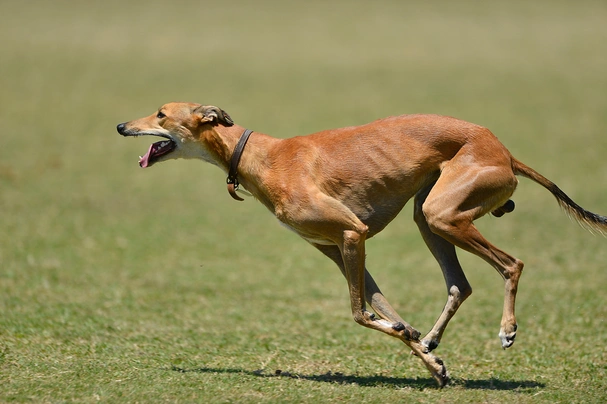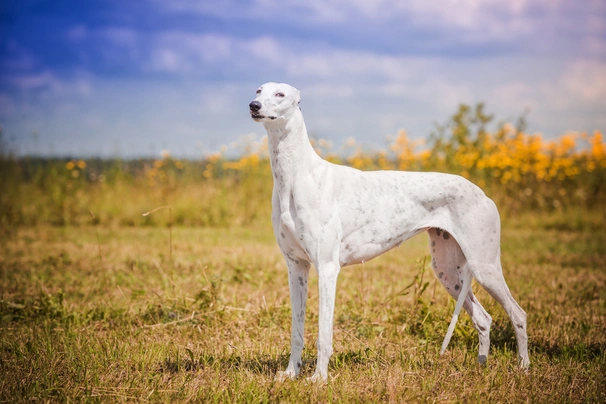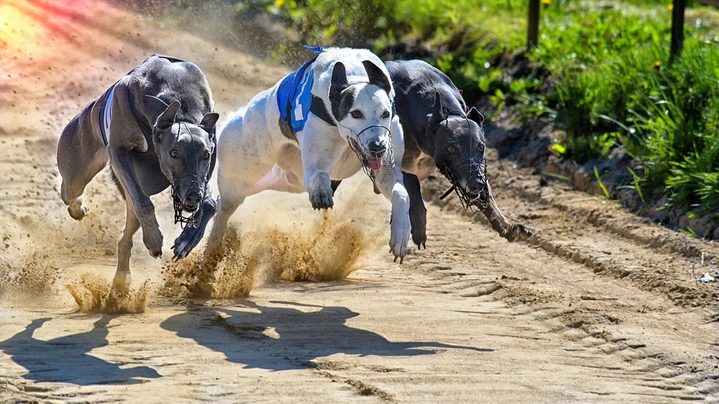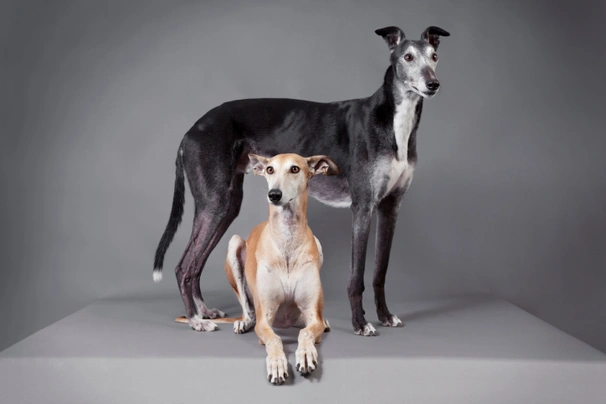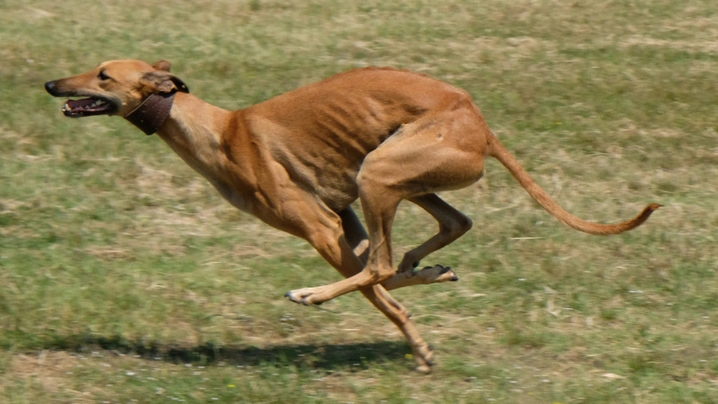Greyhound
Pros
Cons
Introduction of the Greyhound
The Greyhound is an elegant graceful dog that over time has found their way into the hearts and homes of many people both here in the UK and elsewhere in the world and for good reason. They are known to be wonderful companions and family pets that form strong ties with their owners which makes them such a pleasure to have around.
These athletic lean dogs love to let off steam whenever they can but they also know how to chill out and relax which is just one of the reasons why they have consistently remained such a popular breed. They are in a nutshell the most popular of all hound breeds with the added bonus of Greyhounds being low maintenance when it comes to keeping their coats looking good and for such large dogs they are not big eaters either.
History of the Greyhound
There are references to dogs that look very much like the Greyhound in ancient works of art discovered in Egyptian pyramids that date back to 4000 BC and many people believe they were firm favourites with the Pharaohs. With this said there are other people who believe these elegant dogs could have originated in ancient Greece Africa Turkey or the Middle East. What is known is that the Greyhound is an ancient breed that has been around thousands of years.
At one point in time before the Middle Ages when famines spread across the lands Greyhound numbers fell dangerously low but thanks to the fact that nobles and the privileged of the day including royalty made sure these hounds did not vanish altogether by keeping them in their courts. Nobles made it a capital offence to kill one of these hounds and commoners could not own one.
Over the years they found their way to Europe and when they first arrived in England they were to become a definite status symbol. In 1016 only nobles and the elite could own greyhounds thanks to the Canute Law. They became heraldic dogs found on the coat of arms of the royals namely Henry VIII and Charles V of France. As time passed Greyhounds remained popular and were always thought of as being "status" symbols and were depicted in many works of art.
In England Greyhounds were first used for hare coursing but later thanks to their tremendous turn of speed these hounds were used for racing proving themselves to be the fastest dog on the planet. Only the cheetah boasts being faster than a Greyhound in full flight. Today Greyhounds are still one of the most popular choices as family pets and companion dogs because of their kind gentle natures and the fact they seem to have a natural affinity with children.
Interesting facts about the breed
- Is the Greyhound a vulnerable breed? No Greyhounds have consistently remained one of the more popular breeds in the UK and elsewhere in the world ranking 94 out of 238 breeds on the Pets4homes website
- Greyhounds are the only breed to be mentioned in the Bible in Proverbs 30:29-31 King James Version
- They are the fastest dogs in the world
- Greyhounds have a nickname which is "the 40-mph couch potato"
- In mythology the Goddess Diana often has a Greyhound at her side in works of art
- The American president Hayes owned a Greyhound in 1876 and kept his canine companion in the White House
- They are thought to be the most ancient of "hound" breeds
Appearance of the Greyhound
Height at the withers: Males 71 - 76 cm Females 68 - 71 cm
Average weight: Males 27 - 40 kg Females 27 – 34 kg
Greyhounds are athletic muscular and nicely proportioned dogs that boast long heads and necks which adds to their graceful appearance. They have powerful jaws well chiseled muzzles and slight stop. Their eyes are oval shaped and dark in colour with dogs boasting a bright intelligent look about them. Their ears are rose-shaped and small being fine to the touch.
Greyhounds have strong jaws with a perfect scissor bite where their upper teeth neatly overlap their lower ones. Their necks are previously mentioned are long and well-muscled with dogs carrying them arched in an elegant fashion. Shoulders are muscular oblique and well laid back being well defined and their front legs are straight long and boast a good amount of bone.
A Greyhound boasts a deep chest and deep well sprung ribs which are carried well back. Their back is long and broad with dogs boasting powerful slightly arched loins. Hindquarters are well muscled with Greyhounds boasting wide and muscular thighs and second thighs which are proof of their exceptional power. Their feet are moderately long and dog's boast compact well knuckled toes with strong paw pads. Tails are long and set low being stronger at the root before tapering to the tip and which dogs carry low and curved slightly.
When it comes to their coat Greyhounds have fine and close coats which can be a variety of colours. The accepted breed colours for Kennel Club registration are as follows:
- Black
- Black & White
- Black Brindle
- Black Brindle & White
- Blue
- Blue & White
- Blue Brindle
- Blue Brindle White Particolour
- Brindle & White
- Fallow
- Fallow & White
- Fawn
- Fawn & White
- Red
- Red & White
- Red Brindle
- Red Brindle & White
- White
Greyhounds can also have all the above colours with white markings in them which is permissible as a breed standard.
Gait/movement
When a Greyhound moves they do so with tremendous grace and elegance. They can turn quickly at great speed without losing momentum or their balance.
Faults
The Kennel Club frowns on any exaggerations or departures from the breed standard and would judge the faults on how much they affect a dog's overall health and wellbeing as well as their ability to perform.
Males should have both testicles fully descended into their scrotums and it is worth noting that a dog can be a little lighter or heavier as well as slightly taller or shorter than set out in the Kennel Club breed standard which is given as a guideline only.
Temperament of the Greyhound
Greyhounds are affectionate and loyal dogs that boast a very gentle side to their nature. They are intelligent and in the right environment and hands they are easy to train. Once they form a bond with an owner and their family Greyhounds become valued members of the household and enjoy nothing more than being involved in all that goes on from day to day**.**
They love to be out and about but once a Greyhound gets home they chill out and relax. The only downside to their devotion is that these dogs are prone to suffer from separation anxiety if they are left to their own devices even for shorter periods of time. As such they are a great choice of family pet in a household where one family member usually stays at home when everyone else is out of the house.
Because Greyhounds have quite delicate skin care must be taken when they are around other dogs and play time gets a bit rough. They also need to sleep on nice thick bedding because of their delicate frames. The other thing to bear in mind is that these dogs feel the cold and therefore should wear a coat when the weather turns cold or when they go out for a walk in wet and windy conditions. They can be a little wary and aloof around strangers but they rarely show any sort of aggression towards people when they first meet them preferring to remain a little distance away.
Are they a good choice for first time owners?
Greyhounds are not the best choice for first time owners because they need to be trained and handled by people familiar with their specific needs and who have the time to dedicate to such an energetic canine companion. With this said a Greyhound is very happy to turn into a couch potato once they get home after they've been given lots of vigorous exercise.
What about prey drive?
Greyhounds have a very high prey drive which means care must be taken as to where and when they can run free off their leads. If a Greyhounds spots anything in the distance that looks interesting enough to chase they would quickly be off after it paying little attention to any recall commands.
What about playfulness?
Greyhounds are known to have a playful side to their natures and they enjoy playing interactive games with the people they love. Greyhounds are built for speed and love nothing more than to chase things down and why many owners take their canine companions lure coursing which is a great way of letting a dog let off steam doing something that is deeply embedded in their psyche.
What about adaptability?
Greyhounds love to be able to express themselves whenever they can by running free off the lead providing it's in a safe environment. As such they are better suited to people who have large secure back gardens with high fencing rather than people who live in apartments.
What about separation anxiety?
Greyhounds form strong ties with their families and dogs are never very happy when they find themselves left on their own for longer periods of time. They are better suited to people who either work from home or in households where one person stays at home when everyone else is out so they are never alone for any length of time which could see a dog suffering from separation anxiety. This can lead to them being destructive around the home which is a dog's way of relieving any stress they are feeling and a way to keep themselves entertained.
What about excessive barking?
Greyhounds are not known to be "barkers" although some of them like to howl when the mood takes them. With this said any Greyhound that's left on their own for longer periods of time or is unhappy about anything in their environment could start barking to get someone's attention and as a way of showing how unhappy they are about the situation.
Do Greyhounds like water?
Some Greyhounds like swimming and will take to the water whenever they can more especially when the weather is hot but because they have such slight builds they are not terribly buoyant which means they need to be supervised at all times when they are swimming. Anyone who owns a dog that does not like water should never force them to go in because it would just end up scaring them. With this said care should always be taken when walking a Greyhound off the lead anywhere near more dangerous watercourses just in case a dog decides to leap in and then needs rescuing because they can't get out of the water on their own.
Are Greyhounds good watchdogs?
Greyhounds are not natural watchdogs although this is not to say a dog would not be quick off the mark to let an owner know when there are strangers about although they would rarely do this aggressively preferring to keep their distance and alert an owner that something they don't like is going on before retreating out of the way.
Intelligence / Trainability of the Greyhound
Greyhounds are intelligent dogs and they are known to be quite easy to train. They are always willing to learn new commands but because they are sensitive dogs by nature their training should be done gently and carefully to avoid scaring them especially when they are impressionable puppies. However their prey drive is very strong and even a well-trained and good behaved Greyhound might just decide to ignore a recall command if they spot something in the distance they think they should chase.
Greyhound puppies are very cute and they are sensitive characters by nature which is why they need to be treated with care. With this said it would be a mistake to spoil a puppy too much and owners should start out as they mean to go on which means setting down limits and boundaries. This allows puppies to understand what is expected of them although all puppies will test these from time to time. The first commands a puppy should be taught are as follows:
- Come
- Sit
- Stay
- Quiet
- Leave it
- Down
- Bed
Children and other
Greyhounds are gentle characters which is why they make such great family pets but they do need to be well socialised from a young age for them to be confident outgoing and well-rounded mature dogs. They seem to have an affinity with children and tend to be on the best behaviour when they are around them. However any interaction between a dog and the kids should be supervised by an adult to make sure things don’t get too boisterous.
They are usually very good around other dogs but unless a Greyhound has grown up with a family cat care should be taken when they are around cats they don't already know. They should not be trusted with smaller animals because of their high prey drive either. A Greyhound might just see family pets as something they need to chase with disastrous results.
Health of the Greyhound
The average life expectancy of a Greyhound is between 9 and 11 years when properly cared for and fed an appropriate good quality diet to suit their ages.
Greyhounds are true athletes having been bred to race and chase prey. As such their build is quite delicate which means they are prone to injuring themselves and more especially this typically involves injuries to their legs. Other health issues that are worth noting if you are hoping to share your home with one of these laid-back hounds include the following:
- Osteosarcoma
- Neuropathy (GN) - DNA test available
- Congenital deafness - BAER test through the Animal Health Trust (AHT)
- Bloat
- Skin irritations of the tail
- Spinal injuries
- Esophageal malformations
- Sensitivity to drugs
What about vaccinations?
Greyhound puppies would have been given their initial vaccinations before being sold but it is up to their new owners to make sure they have their follow-up shots in a timely manner with the vaccination schedule for puppies being as follows:
- 10 -12 weeks old bearing in mind that a puppy would not have full protection straight away but would be fully protected 2 weeks after they have had their second vaccination
There has been a lot of discussion about the need for dogs to have boosters. As such it's best to talk to a vet before making a final decision on whether a dog should continue to have annual vaccinations which are known as boosters.
What about spaying and neutering?
A lot of vets these days recommend waiting until dogs are slightly older before spaying and neutering them which means they are more mature before undergoing the procedures. As such they advise neutering males and spaying females when they are between the ages of 6 to 9 months old and sometimes even when a dog is 12 months old.
Other vets recommend spaying and neutering dogs when they are 6 months old but never any earlier unless for medical reasons. With this said many breeds are different and it is always advisable to discuss things with a vet and then follow their advice on when a dog should be spayed or neutered.
What about obesity problems?
Some Greyhounds gain weight after they have been spayed or neutered and it's important to keep an eye on a dog's waistline just in case they do. If a dog starts to put on weight it's important to adjust their daily calorie intake and to up the amount of exercise they are given. Older dogs too are more prone to gaining weight and again it's essential they be fed and exercised accordingly because obesity can shorten a dog's life by several years. The reason being that it puts a lot of extra strain on a dog's internal organs including the heart which could prove fatal.
What about allergies?
Greyhounds are prone to suffering from allergies and it's important for a dog to see a vet sooner rather than later if one flares up paying special attention to a dog's tail. Allergies can be notoriously hard to clear up and finding the triggers can be challenging. With this said a vet would be able to make a dog with an allergy more comfortable while they try to find out the triggers which could include the following:
- Certain foods especially commercially produced dog food that contains high levels of grain and other cereal fillers
- Airborne pollens
- Dust mites
- Environment
- Flea and tick bites
- Chemicals found in everyday household cleaning products
Participating in health schemes
All responsible Greyhound breeders would ensure that their stud dogs are tested for known hereditary and congenital health issues known to affect the breed by using the following schemes:
- DNA test – Neuropathy
- BAER test - Congenital deafness through the Animal Health Trust (AHT)
What about breed specific breeding restrictions?
Apart from the standard breeding restrictions for all Kennel Club registered breeds there are no further breed specific breeding restrictions in place for the Greyhound. With this said prospective owners should always ask breeders about health concerns known to affect Greyhounds and to see health test results of parent dogs before committing to buy a puppy from them.
What about Assured Breeder Requirements?
For the moment there are no DNA tests or BVA screening schemes under the Assured Breeder Scheme for the Greyhound. The tests that are available for the breed are as follows:
- DNA test for Neuropathy (GN)
- BAER test for congenital deafness through the Animal Health Trust (AHT)
Caring for the Greyhound
As with any other breed Greyhounds need to be groomed on a regular basis to make sure their coats and skin are kept in tip-top condition. They also need to be given regular daily exercise to ensure they remain fit and healthy. On top of this they need to be fed good quality food that meets all their nutritional needs throughout their lives.
Caring for a Greyhound puppy
Greyhound puppies are boisterous and full of life which means it's essential for homes and gardens to be puppy-proofed well in advance of their arrival. A responsible breeder would have well socialised their puppies which always leads to more outgoing confident and friendly dogs right from the word go. With this said any puppy is going to feel vulnerable when they leave their mother and littermates which must be taken into account. The longer a puppy can remain with their mother the better although it should never be for too long either.
It's best to pick a puppy up when people are going to be around for the first week or so which is the time needed for a puppy to settle in. Puppy-proofing the home and garden means putting away any tools and other implements that a boisterous puppy might injure themselves on. Electric wires and cables must be put out of their reach because puppies love chewing on things. Toxic plants should be removed from flowerbeds and the home too.
Puppies need to sleep a lot to grow and develop as they should which means setting up a quiet area that's not too out of the way means they can retreat to it when they want to nap and it's important not to disturb them when they are sleeping. It's also a good idea to keep "playtime" nice and calm inside the house and to have a more active "playtime" outside in the garden which means puppies quickly learn to be less boisterous when they are inside.
The documentation a breeder provides for a puppy must have all the details of their worming date and the product used as well as the information relating to their microchip. It is essential for puppies to be wormed again keeping to a schedule which is as follows:
- Puppies should be wormed at 6 months old
- They need to be wormed again when they are 8 months old
- Puppies should be wormed when they are 10 months old
- They need to be wormed when they are 12 months old
Things you'll need for your puppy
There are certain items that new owners need to already have in the home prior to bringing a new puppy home. It's often a good idea to restrict how much space a puppy plays in more especially when you can't keep an eye on what they get up to bearing in mind that puppies are often quite boisterous which means investing in puppy gates or a large enough playpen that allows a puppy the room to express themselves while keeping them safe too. The items needed are therefore as follows:
- Good quality puppy or baby gates to fit on doors
- A good well-made playpen that's large enough for a puppy to play in so they can really express themselves as puppies like to do
- Lots of well-made toys which must include good quality chews suitable for puppies to gnaw on bearing in mind that a puppy will start teething anything from when they are 3 to 8 months old
- Good quality feed and water bowls which ideally should be ceramic rather than plastic or metal
- A grooming glove
- A slicker brush or soft bristle brush
- Dog specific toothpaste and a toothbrush
- Scissors with rounded ends
- Nail clippers
- Puppy shampoo and conditioner which must be specifically formulated for use on dogs
- A well-made dog collar or harness
- A couple of strong dog leads
- A well-made dog bed that's not too small or too big
- A well-made dog crate for use in the car and in the home that's large enough for a puppy to move around in
- Baby blankets to put in your puppy's crate and in their beds for when they want to nap or go to sleep at night
Keeping the noise down
All puppies are sensitive to noise including Greyhound puppies because they are ultra-sensitive to loud sounds. It's important to keep the noise levels down when a new puppy arrives in the home. TVs and music should not be played too loud which could end up stressing a small puppy out.
Keeping vet appointments
As previously mentioned Greyhound puppies would have been given their first vaccinations by the breeders but they must have their follow up shots which is up to their new owners to organise. The vaccination schedule for puppies is as follows:
- 10 -12 weeks old bearing in mind that a puppy would not have full protection straight away but would only be fully protected 2 weeks after they have had their second vaccination
When it comes to boosters it's best to discuss these with a vet because there is a lot of debate about whether a dog really needs them after a certain time. However if a dog ever needed to go into kennels their vaccinations would need to be
What about older Greyhounds when they reach their senior years?
Older Greyhounds need lots of special care because as they reach their golden years they are more at risk of developing certain health concerns. Physically a dog's muzzle may start to go grey but there will be other noticeable changes too which includes the following:
- Coats become coarser
- A loss of muscle tone
- Greyhounds can either become overweight or underweight
- They have reduced strength and stamina
- Older dogs have difficulty regulating their body temperature
- They often develop arthritis
- Immune systems do not work as efficiently as they once did which means dogs are more susceptible to infections
Older dogs change mentally too which means their response time tends to be slower as such they develop the following:
- They respond less to external stimuli due to impaired vision or hearing
- They tend to be a little pickier about their food
- They have a lower pain threshold
- Become intolerant of any change
- Often an older dog can feel disorientated
Living with a Greyhound in their golden years means taking on a few more responsibilities but these are easily managed and should include taking a look at their diet the amount of exercise they are given how often their dog beds need changing and keeping an eye on the condition of their teeth.
Older Greyhounds need to be fed a good quality diet that meets their needs at this stage of their lives all the while keeping a close eye on a dog's weight. A rough feeding guide for older dogs is as follows bearing in mind they should be fed highly digestible food that does not contain any additives:
- Protein content should be anything from 14 – 21%
- Fat content should be less than 10%
- Fibre content should be less than 4%
- Calcium content should be 0.5 – 0.8%
- Phosphorous content should be 0.4 – 0.7%
- Sodium content should be 0.2 – 0.4%
Older Greyhounds don't need to be given the same amount of daily exercise as a younger dog but they still need the right amount of physical activity to maintain muscle tone and to prevent a dog from putting on too much weight. All dogs need access to fresh clean water and this is especially true of older dogs when they reach their golden years because they are more at risk of developing kidney disorders.
Grooming of the Greyhound
Greyhounds are low maintenance in the grooming department thanks to their tight short and close coats which means a once over with a bristle brush once a week would keep them gleaming. It's also important to keep an eye on their ears and to clean them on a regular basis to make sure there are no infections taking hold which can be very hard to treat once they flare up.
Exercise of the Greyhound
Greyhounds need to be given a minimum of an hour's daily exercise. However they do not need to be given a tremendous amount even though they look so athletic. Ideally a shorter walk in the morning followed by a longer one in the afternoon of around 40 minutes would be enough to keep them fit happy and healthy. They also love to be able to run around in a back garden where they can really let off steam as often as possible. However the fencing must be high and very secure to keep a Greyhound in bearing in mind that these dogs are very good at jumping great heights.
It's also not a good idea to let a Greyhound off a lead when they are being exercised in any public places unless that is they are extremely well-trained because their instinct to chase anything that moves may well get the better of them. The other thing to bear in mind is that Greyhounds are very good at injuring their legs all thanks to the fact they run so fast even over rough ground when allowed to.
Feeding of the Greyhound
If you get a Greyhound puppy from a breeder they would give you a feeding schedule and it's important to stick to the same routine feeding the same puppy food to avoid any tummy upsets. You can change a puppy's diet but this needs to be done very gradually always making sure they don't develop any digestive upsets and if they do it's best to put them back on their original diet and to discuss things with the vet before attempting to change it again.
Older dogs are not known to be fussy finicky or big eaters but this does not mean you can feed them a lower quality diet. It's best to feed a mature dog twice a day once in the morning and then again in the evening making sure it's good quality food that meets all their nutritional requirements. It's also important that dogs be given the right amount of exercise so they burn off any excess calories or they might gain too much weight which can lead to all sorts of health issues. Obesity can shorten a dog's life by several years so it's important to keep an eye on their waistline from the word go.
Because Greyhounds are prone to suffering from bloat it's important not to feed them just before they go out for walk or when they just get back from one. Feeding a dog before any strenuous exercise or when they have just come back from a walk puts them at great risk of suffering from bloat which can prove fatal.
Feeding guide for a Greyhound puppy
Puppies need to be fed a highly nutritious good quality diet for them to develop and grow as they should. As a rough guide a Greyhound puppy can be fed the following amounts every day making sure their meals are evenly spread out throughout the day and it's best to feed them 3 or 4 times a day:
- 2 months old - 264g to 298g depending on puppy's build
- 3 months old - 327g to 386g depending on puppy's build
- 4 months old - 354g to 425g depending on puppy's build
- 5 months old - 381g to 495g depending on puppy's build
- 6 months old - 405g to 557g depending on puppy's build
- 7 months old - 403g to 559g depending on puppy's build
- 8 months old - 374g to 524g depending on puppy's build
- 9 months old - 349g to 491g depending on puppy's build
- 10 months old - 318g to 458g depending on puppy's build
- 11 months old - 290g to 429g depending on puppy's build
- 12 months old - 288g to 402g depending on puppy's build
- 13 months old - 286g to 399g depending on puppy's build
- 14 months old - 286g to 395g depending on puppy's build
Once a puppy is 15 months old they can be fed adult dog food.
Feeding guide for an adult Greyhound
Once fully mature an adult Greyhound must be fed a good quality diet to ensure their continued good health. As a rough guide an adult Greyhound can be fed the following amounts every day:
- Dogs weighing 27 kg can be fed 276g to 363g depending on activity
- Dogs weighing 34 kg can be fed 337g to 443g depending on activity
- Dogs weighing 40 kg can be fed 381g to 501g depending on activity
Greyhound price
If you are looking to buy a Greyhound you would need to pay anything from £200 to over £400 for a well-bred pedigree puppy. The cost of insuring a male 3-year-old Greyhound in northern England would be £23.19 a month for basic cover but for a lifetime policy this would set you back £49.23 a month (quote as of January 2018). When insurance companies calculate a pet's premium they factor in several things which includes where you live in the UK and a dog's age and whether they have been neutered or spayed.
When it comes to food costs you need to buy the best quality food whether wet or dry to feed your dog throughout their lives making sure it suits the different stages of their lives. This would set you back between £30 - £40 a month. On top of this you would need to factor in veterinary costs if you want to share your home with a Greyhound and this includes their initial vaccinations their annual boosters the cost of neutering or spaying your dog when the time is right and then their yearly health checks all of which quickly adds up to over a £1000 a year.
As a rough guide the average cost to keep and care for a Greyhound would be between £50 to £100 a month depending on the level of insurance cover you opt to buy for your dog but this does not include the initial cost of buying a responsibly bred healthy Kennel Club registered pedigree Greyhound puppy.
Buying advice
When visiting and buying any puppy or dog there are many important things to consider and questions to ask of the breeder/seller. You can read our generic puppy/dog advice here which includes making sure you see the puppy with its mother and to verify that the dog has been wormed and microchipped.
Greyhounds have consistently remained one of the more popular breeds both in which means that well-bred puppies can often command a lot of money. As such with Greyhounds there is specific advice questions and protocols to follow when buying a puppy which are as follows:
- Beware of online scams and how to avoid them. You may see online and other adverts by scammers showing images of beautiful Greyhoundpuppies for sale at very low prices. However the sellers ask buyers for money up front before agreeing to deliver a puppy to a new home. Potential buyers should never buy a puppy unseen and should never pay a deposit or any other money online to a seller. You should always visit the pet at the sellers home to confirm they are genuine and make a note of their address.
- As previously touched upon Greyhounds are among some of the most popular breeds in the UK. As such there are many amateur breeders/people who breed from dam far too often so they can make a quick profit without caring for the welfare of the puppies their dam or the breed in general. Under Kennel Club rules a dam can only produce 4 litters and she must be between a certain age to do so. Anyone wishing to buy a Greyhound puppy should think very carefully about who they purchase their puppy from and should always ask to see the relevant paperwork pertaining to a puppy's lineage their vaccinations and their microchipping.
